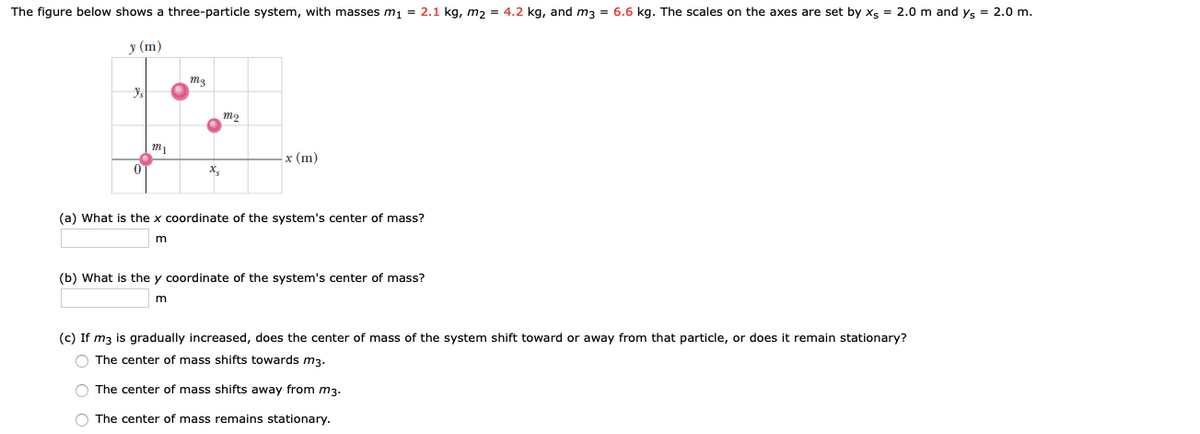The figure below shows a three-particle system, with masses m, = 2.1 kg, m2 = 4.2 kg, and m3 = 6.6 kg. The scales on the axes are set by xg = 2.0 m and ys = 2.0 m. у (m) x (m) x, (a) What is the x coordinate of the system's center of mass? (b) What is the y coordinate of the system's center of mass? (c) If m3 is gradually increased, does the center of mass of the system shift toward or away from that particle, or does it remain stationary? O The center of mass shifts towards m3. O The center of mass shifts away from m3. O The center of mass remains stationary.
The figure below shows a three-particle system, with masses m, = 2.1 kg, m2 = 4.2 kg, and m3 = 6.6 kg. The scales on the axes are set by xg = 2.0 m and ys = 2.0 m. у (m) x (m) x, (a) What is the x coordinate of the system's center of mass? (b) What is the y coordinate of the system's center of mass? (c) If m3 is gradually increased, does the center of mass of the system shift toward or away from that particle, or does it remain stationary? O The center of mass shifts towards m3. O The center of mass shifts away from m3. O The center of mass remains stationary.
Physics for Scientists and Engineers with Modern Physics
10th Edition
ISBN:9781337553292
Author:Raymond A. Serway, John W. Jewett
Publisher:Raymond A. Serway, John W. Jewett
Chapter9: Linear Momentum And Collisions
Section: Chapter Questions
Problem 28P: The vector position of a 3.50-g particle moving in the xy plane varies in time according to...
Related questions
Topic Video
Question

Transcribed Image Text:The figure below shows a three-particle system, with masses m, = 2.1 kg, m, = 4.2 kg, and m3 = 6.6 kg. The scales on the axes are set by xg = 2.0 m and ys = 2.0 m.
у (m)
m3
m2
х (m)
(a) What is the x coordinate of the system's center of mass?
(b) What is the y coordinate of the system's center of mass?
m
(c) If m3 is gradually increased, does the center of mass of the system shift toward or away from that particle, or does it remain stationary?
The center of mass shifts towards m3.
The center of mass shifts away from m3.
The center of mass remains stationary.
Expert Solution
This question has been solved!
Explore an expertly crafted, step-by-step solution for a thorough understanding of key concepts.
This is a popular solution!
Trending now
This is a popular solution!
Step by step
Solved in 4 steps

Knowledge Booster
Learn more about
Need a deep-dive on the concept behind this application? Look no further. Learn more about this topic, physics and related others by exploring similar questions and additional content below.Recommended textbooks for you

Physics for Scientists and Engineers with Modern …
Physics
ISBN:
9781337553292
Author:
Raymond A. Serway, John W. Jewett
Publisher:
Cengage Learning

Physics for Scientists and Engineers: Foundations…
Physics
ISBN:
9781133939146
Author:
Katz, Debora M.
Publisher:
Cengage Learning

University Physics Volume 1
Physics
ISBN:
9781938168277
Author:
William Moebs, Samuel J. Ling, Jeff Sanny
Publisher:
OpenStax - Rice University

Physics for Scientists and Engineers with Modern …
Physics
ISBN:
9781337553292
Author:
Raymond A. Serway, John W. Jewett
Publisher:
Cengage Learning

Physics for Scientists and Engineers: Foundations…
Physics
ISBN:
9781133939146
Author:
Katz, Debora M.
Publisher:
Cengage Learning

University Physics Volume 1
Physics
ISBN:
9781938168277
Author:
William Moebs, Samuel J. Ling, Jeff Sanny
Publisher:
OpenStax - Rice University

Physics for Scientists and Engineers
Physics
ISBN:
9781337553278
Author:
Raymond A. Serway, John W. Jewett
Publisher:
Cengage Learning

Classical Dynamics of Particles and Systems
Physics
ISBN:
9780534408961
Author:
Stephen T. Thornton, Jerry B. Marion
Publisher:
Cengage Learning

Principles of Physics: A Calculus-Based Text
Physics
ISBN:
9781133104261
Author:
Raymond A. Serway, John W. Jewett
Publisher:
Cengage Learning